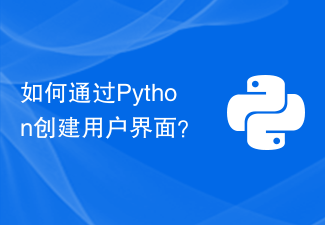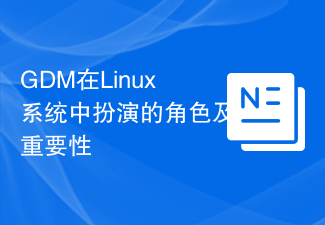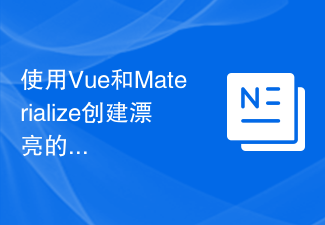 Web Front-end
Web Front-end CSS Tutorial
CSS Tutorial The Art of CSS Development: Project Experience Leads You to Create Unique User Interfaces
The Art of CSS Development: Project Experience Leads You to Create Unique User Interfaces
The Art of CSS Development: Project Experience Takes You to Create Unique User Interfaces
With the continuous development of Internet technology, the design and development of user interfaces have become an important issue for various websites and websites. important part of the application. CSS, as a technology used for web page style layout and design, plays an important role in creating user-friendly interfaces. In this article, I will share some of the art of CSS development through my project experience and lead you to create unique user interfaces.
First of all, a good user interface should be simple and easy to use. CSS can help achieve this. In projects, I often use CSS to optimize page layouts to make them clearer and easier to navigate. By setting appropriate margins and spacing, using canonical naming conventions, and choosing appropriate fonts and colors, we can create a user interface that is clean and easy to use.
Secondly, CSS is also customizable. By using various properties and selectors of CSS, we are able to customize a unique interface according to the needs of the project. For example, we can use CSS animations and transition effects to create smooth and engaging interactive experiences. We can also use responsive design to optimize the display effect of the interface according to different devices and screen sizes. These can make the user interface more personal and increase user engagement and satisfaction.
In addition, CSS development also needs to pay attention to some common problems. For example, browser compatibility is an important consideration. Different browsers have different levels of support for CSS, and we need to do compatibility testing and repair work to ensure the consistency of the interface in various browsers. In addition, we should also pay attention to the optimization and performance adjustment of CSS code and avoid using too many selectors and styles to improve page loading speed and user experience.
In my project experience, I also learned some CSS development skills and tools. For example, using CSS preprocessors makes it easier to write and manage style code. Preprocessors such as Sass and Less provide more functions and tools, such as variables, mixins, nesting, etc., making the development process more efficient and flexible. In addition, CSS frameworks such as Bootstrap and Foundation can also help us quickly build and beautify the interface, providing a series of ready-made styles and components.
Finally, a successful CSS development requires continuous learning and updating. Internet technology is constantly improving, and new CSS properties and technologies are constantly emerging. To stay competitive, we need to actively learn and try new technologies and methods. Participating in community discussions and participating in related events is also a good way to communicate and share experiences with other developers and make progress together.
To sum up, CSS development does have its art. By rationally using various properties and techniques of CSS, we can create unique and user-friendly interfaces. From simplicity and ease of use to customization to compatibility and performance tuning, we need to continuously practice and improve in the project. Through continuous learning and updating, we can become an excellent CSS developer and provide users with better experience and interface design.
The above is the detailed content of The Art of CSS Development: Project Experience Leads You to Create Unique User Interfaces. For more information, please follow other related articles on the PHP Chinese website!
 如何通过Python创建用户界面?Aug 26, 2023 am 09:17 AM
如何通过Python创建用户界面?Aug 26, 2023 am 09:17 AM在本文中,我们将学习如何使用python创建用户界面。什么是图形用户界面?术语“图形用户界面”(或“GUI”)是指一组可以在计算机软件中交互以显示信息和交互的视觉元素项目。为了响应人类输入,对象可能会改变颜色、大小和可见度等外观特征。图标、光标和按钮等图形组件可以通过音频或视觉效果(如透明度)进行增强,以创建图形用户界面(GUI)。如果您希望更多人使用您的平台,您需要确保它具有良好的用户界面。这是因为这些因素的结合会极大地影响您的应用或网站提供的服务质量。Python被开发人员广泛使用,因为它提
 GDM在Linux系统中扮演的角色及重要性Mar 01, 2024 pm 06:39 PM
GDM在Linux系统中扮演的角色及重要性Mar 01, 2024 pm 06:39 PMGDM在Linux系统中扮演的角色及重要性GDM(GnomeDisplayManager)是Linux系统中一个重要的组件,主要负责管理用户登录和注销过程,以及提供用户界面的显示和交互功能。本文将详细介绍GDM在Linux系统中的角色及其重要性,并提供具体的代码示例。一、GDM在Linux系统中的角色用户登录管理:GDM负责启动登录界面,接受用户输入用户
 Golang和Template包:创建个性化的用户界面Jul 18, 2023 am 10:27 AM
Golang和Template包:创建个性化的用户界面Jul 18, 2023 am 10:27 AMGolang和Template包:创建个性化的用户界面在现代的软件开发中,用户界面往往是用户与软件进行互动的最直接的途径。为了提供一个好用、美观的用户界面,开发者需要灵活的工具来创建和定制用户界面。而在Golang中,开发者可以使用Template包来实现这一目标。本文将介绍Golang和Template包的基本用法,并通过代码示例展示如何创建个性化的用户界
 通过 PHP 防抖技术实现流畅的用户界面Oct 12, 2023 am 10:21 AM
通过 PHP 防抖技术实现流畅的用户界面Oct 12, 2023 am 10:21 AM通过PHP防抖技术实现流畅的用户界面随着Web技术的快速发展,用户越来越追求良好的用户体验。对于前端开发来说,实现流畅的用户界面是非常重要的一项任务。而对于后端开发来说,如何通过服务器端技术来提升用户界面的流畅度也是一个挑战。一种常见的提升用户界面流畅度的方式是通过防抖技术来减少不必要的请求或操作。防抖技术可以在用户频繁操作时,只执行最后一次操作,从
 Win11好用吗Dec 25, 2023 pm 06:37 PM
Win11好用吗Dec 25, 2023 pm 06:37 PMwin11系统还是非常好用的,综合性能相较于win10还是有了很大的提升,而且这次的win11更新增加了很多的亮点,不过新系统有很多的bug在更新的时候还是要慎重考虑。Win11系统好用吗:答:好用win11系统总的来说还是十分好用的,虽然说有些方面不如win10。但是总体性能来说还是比win10要更加出色一点,稳定性方面就比较差了。win11亮点介绍:1、支持64位处理器,而且安装包更加的小,整体变得更加省电。2、ui界面得到了很好的改善,窗口都变成了圆角。3、在游戏画面,游戏帧数方面得到了很
 为何很少人选择使用win8?Jan 04, 2024 pm 06:59 PM
为何很少人选择使用win8?Jan 04, 2024 pm 06:59 PM用户在下载安装Windows的系统时,很少有人会使用win8的系统,这是因为人们在安装使用过win8系统之后的体验感并不好,所以人们就会选择其他系统。win8为什么很少人用1、兼容性差win8系统对于一些常用的软件都不兼容,用户如果想要使用2000年以前的软件,根本用不了。2、软件少在win8系统的应用商店中,软件数量很少,而且用户下载软件速度很慢,打开使用软件也慢。3、资源占用多win8系统的占用资源非常多,,而且这样会导致用户的电脑发热,然后CPU降频直接影响性能。4、界面设计差win8的系
 比较介绍win7和win11操作系统Jan 04, 2024 pm 03:02 PM
比较介绍win7和win11操作系统Jan 04, 2024 pm 03:02 PM最近,微软一步步在为win11造势,越来越多的相关消息被泄露出来,几乎已经确定了win11将要面世。因此有很多还在使用win7的朋友想知道win7和win11哪个好,小编今天就给大家带来了二者对比,下面一起来看一下吧。win7和win11哪个好答:win7和win11各有优势,很难说哪个更好。1、首先,win7是一款经历了很长时间考验的系统,而win11才刚刚诞生,稳定性方面肯定win7更好。2、但是win7已经停止更新和服务很久了,而win11是最新的操作系统,因此win11更加适合现在的用户
 使用Vue和Materialize创建漂亮的用户界面Dec 27, 2023 am 08:38 AM
使用Vue和Materialize创建漂亮的用户界面Dec 27, 2023 am 08:38 AM在现代的软件开发过程中,构建一个美观、易用的用户界面是至关重要的。当今的用户对于应用程序的界面设计和用户体验要求越来越高,因此,开发人员需要选择一种适合他们项目的技术来构建出令人满意的用户界面。Vue.js和Materialize是两个在市场上流行的技术,它们相辅相成,可以配合使用来快速构建美观的用户界面。Vue.js是一种用于构建用户界面的JavaScri


Hot AI Tools

Undresser.AI Undress
AI-powered app for creating realistic nude photos

AI Clothes Remover
Online AI tool for removing clothes from photos.

Undress AI Tool
Undress images for free

Clothoff.io
AI clothes remover

AI Hentai Generator
Generate AI Hentai for free.

Hot Article

Hot Tools

Atom editor mac version download
The most popular open source editor

Dreamweaver CS6
Visual web development tools

Safe Exam Browser
Safe Exam Browser is a secure browser environment for taking online exams securely. This software turns any computer into a secure workstation. It controls access to any utility and prevents students from using unauthorized resources.

MantisBT
Mantis is an easy-to-deploy web-based defect tracking tool designed to aid in product defect tracking. It requires PHP, MySQL and a web server. Check out our demo and hosting services.

Zend Studio 13.0.1
Powerful PHP integrated development environment





